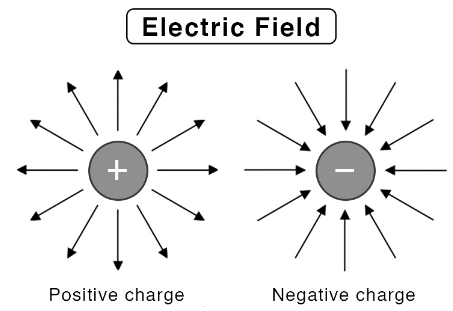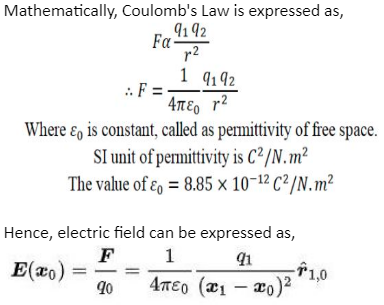An electric field is a physical field associated with each point present in the space and surrounds the charges that may be present in any form. An electric field has the ability to exert force either by repulsion or by attraction on all the surrounding charged particles. The magnitude as well as the direction of the electric field can be expressed by electric field strength, which is denoted by the symbol E. The electric field strength can also be called electric field intensity or electric field. This can be understood by the following given electric field example in the form of a diagram.

Electric charge
Electric field is a vector quantity having both magnitudes and direction. It is basically the force experienced by every point carrying a positive charge. Thus, electric force is the result of a phenomenon called electric charge. Electric charges produce a region in space around electrically charged particles, where differently charged particles may feel the force. In an electric field, a charge is considered the source of an electric field when it extends in an outward manner into the surrounding space. The force exerted by the first particle over the second particle in this region may be defined as a direct interaction between the second charge as well as the electric field.
Mathematically, the electric field is expressed in the form of the equation,
E=F/Q
Where,
E = Electric field,
F = Force
Q = Charge
What are the dimensions of an electric field?
We can see in the electric field notes that the electric field is expressed in force per unit charge. In the SI system, the units are expressed in Newtons per Coulomb, which is almost equivalent to Volts per meter. In the CGS system, the units are expressed in Dynes per Electrostatic Unit, which is equivalent to Statvolts per centimeter.
Being a vector quantity, the electric field is assigned arrows going towards and away from charges. Electric field acts in the same way as a gravitational field between two masses. Thus, in the electric field notes, we can see that the electric field obeys the inverse square law with the distance. It can be understood efficiently through Coulomb’s Law.
Coulomb’s Law
Coulomb’s Law states that the magnitude of the force between two point charges is directly proportional to the charge magnitude and inversely proportional to the distance between the two charges. It can be understood clearly by the following statement: if the source charge is doubled, the electric field would be doubled; and if we move away from a source, the electric field would have an extremely low strength, which is only about one-quarter of its strength with respect to the original.

The direction of an electric field
The directions of an electric field exerted by positive and negative charges are opposite to each other. The direction of a positive charge is chosen as the direction of the electric field. Since like charges repel each other, the electric field surrounding an isolated positive charge is outwardly radiated. If the electric field is expressed in the form of field lines or lines of force, it is considered as starting on positive charge and ending on negatively charged species. The line tangent to the electric field is used to express the direction of the electric field at a particular point.
Strength of an electric field
The region where field lines are in close contact with each other experiences a strong electric field as compared to the region where these field lines are far apart.
Electric field examples
Capacitors and cells of batteries generate electric fields due to their charges and their configurations. Radio waves, light, x-rays, etc., contain components related to the electric field.
Types of electric field
- Electrostatic Fields
- Uniform Fields
- Electrodynamics Fields
- Electric displacement Field
Electrostatic Fields: These fields do not change with respect to time. They can be seen when there are no changes in the system of charged matter, and they remain stationary.
Uniform Fields: As the name suggests, they are constant at each point. Its approximation is usually achieved by the placement of conducting plates in parallel manner and maintaining a proper voltage between them.
Electrodynamics Fields: An electrodynamic field is an electric field example which has a tendency to change with time when the charges remain in motion.
Electric Displacement Field: Electric Displacement Field is also referred to as electric induction. It is a type of vector field that can be found in the Maxwell’s equation section of electric field notes. It is expressed by the symbol D, which corresponds to the term displacement. It accounts for the effects shown by charges that may remain free or may be bound within materials.
Expression of electric field with respect to different point charges
Electric field near an isolated point charge
The electric field near an isolated point charge can be expressed by the equation,

The direction of the electric field points away from the positive charge and towards the negative charge. It can be seen that the magnitude of the electric field falls at a rate of 1r2 as we move away from the point charge.
Expression of an electric field towards multiple point charges
This electric field can be expressed by the summation of the fields from each point charge. The type of summation is a vector sum.

Expression of an electric field towards distributed charges
If the charges are expressed as continuous distribution, then the summation is to be taken as an integral.

Here, r is the distance between dq and the region of utmost interest, while r is the direction of force in a linear way between dq and the region of interest.
Conclusion
Electric field is a force experienced by a point charge in the surrounding space. It is a vector quantity having both direction and magnitude. It is expressed in Newtons per Coulomb. Mathematically, electric field is expressed in the form of the equation E=F/Q, where E stands for electric field, F stands for force and Q stands for charge. Electric field is expressed by Coulomb’s law.
 Profile
Profile Settings
Settings Refer your friends
Refer your friends Sign out
Sign out





